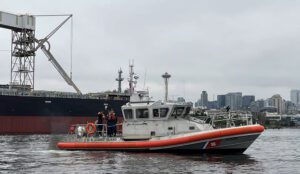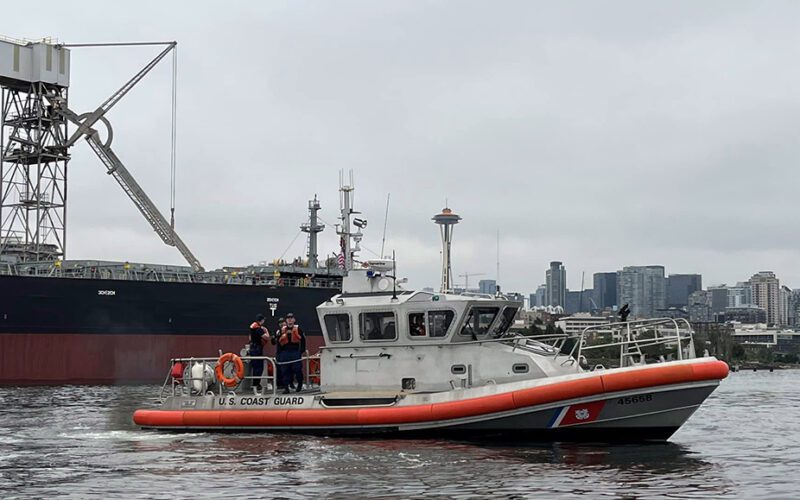
The U.S. Coast Guard’s proposal to expand Base Seattle has set off a buzzsaw of issues among port neighbors and regulatory agencies – federal, state and local.
The Guard has been challenged across numerous fronts. A common message is that while most people support the Coast Guard’s mission and acknowledge the need for expansion and modernization at Base Seattle, the Guard’s current draft proposal, released in October, is drastic, a steam roller that flattens everything in its path.
Consider: “Coast Guard land acquisition under any of the alternatives would result in direct, significant adverse impacts associated with displacement of existing uses and inconsistency with local land-use plans.”
That conclusion is from the Coast Guard’s recent draft environmental impact statement.
Base Seattle, south of downtown on Puget Sound, is the largest Guard installation in the Pacific Northwest, essential for regional missions and polar activities, and homeport for polar ice breakers and northwest cutters.
Most buildings and infrastructure were constructed before 1950, and many were repurposed over the years. This, the Guard has said, impedes its ability to efficiently execute its missions.
The Coast Guard’s proposal would expand the base from 22 to possibly 54 acres. In October, the agency released its draft Programmatic Environmental Impact Statement (PEIS). The analysis considered three expansion alternatives which vary in configurations and territory. The Guard wants to move ahead with what’s called Alternative 1.
The PEIS details the impacts from a base expansion. The release of the draft PEIS also started a public comment period, which ended in December. A review of the comments shows strong and widespread dissatisfaction across the waterfront and that the draft leaves important issues unresolved.
Here’s a look at some of these concerns among Port of Seattle businesses and organizations.
Business and Labor
When the Guard announced in May 2021 that it was beginning an environmental review, the military branch also asked for comments regarding how wide or narrow the scope of the study should be, i.e., what should be included in addition to standard environmental measures such as potential impacts on air and water quality or endangered species or hazardous materials.
The Guard received more than 20 letters from businesses, labor, federal and state environmental agencies and local public health authorities.
The International Longshore and Warehouse Union (ILWU), which has more than 1,000 members working at the Port of Seattle, was one of the entities that responded. Their concerns included:
- Loss of parking. Worker parking is critical because port job schedules and assignments don’t align with available transit.
- The possible demolition of Terminal 46, a critical facility for container freight and cargo and employment.
- Maintaining security for people and hazardous cargo during construction.
The fate of Terminal 46 is a focus of particular attention throughout the PEIS documents. The terminal covers about 86 acres and is used as a marine cargo terminal that can accommodate throughput of up to 600,000 TEUs per year.
The longshore union suggests 10 other locales that might meet the Coast Guard’s operational needs – sites that the union suggests should be part of the study.
The Seattle Mariners, who play at T-Mobile Park, located close to Terminal 46, also sent a letter. The MLB team’s letter notes the park’s importance for Seattle’s SoDo neighborhood, attracting almost three million people each year, and that the Stadium District is critical for the city’s tax base and employment.
The Mariners asked the Coast Guard to focus on four issues within the EIS:
- Traffic and parking
- Land use impacts
- Construction impacts; and,
- “Project” versus “programmatic EIS” – this references a clarification about the Guard’s EIS process, suggesting that perhaps planning had advanced more than the public had been made aware.
The issues raised by the Mariners were mentioned repeatedly by other business and economic development groups seeking to inform the scope of the work.
One of the most detailed and lengthy scoping letters was submitted jointly by the Port of Seattle and the Northwest Seaport Alliance (NWSA).
They write: Port (of) Seattle is a gateway that “cannot be replicated elsewhere and provides a crucial function in the resiliency of our state’s economy. For the port and NWSA to be successful in our mission, it is critical that other jurisdictions and government agencies like the U.S. Coast Guard recognize the complicated nature of our operations and collaborate closely when major projects might impact our assets.”
Within its 14 pages, the letter presents specific topics to be included within the Coast Guard’s EIS. These topics range from transportation access to tribal concerns to stormwater to greenhouse gas emissions.
The issues highlighted by the port and NWSA are also repeatedly mentioned within the comments sent by many groups operating within or around Port Seattle, including the local development group Alliance for Pioneer Square, Washington DOT and the city’s Department of Construction & Inspections.
Questions remain
Now that the EIS is published it’s worth a look back: did the Coast Guard address the numerous issues suggested for inclusion at the start of the EIS process?
The Guard’s October draft EIS is clear about impacts from expansion. In the executive summary regarding land use, the Coast Guard writes that while the expansion to 54 acres represents less than 3% of total port property “it would nevertheless displace existing uses that may or may not be able to be relocated elsewhere within the port and preclude any future uses of the acquired property.”
In a December 2022 16-page letter sent in response to the draft, the ILWU requests that the Coast Guard publish a revised DEIS that “fully evaluates socio-economic, environmental justice, and related impacts and considers a blended alternative with a reduced footprint of expansion.”
Sixteen Washington state representatives sent a letter to the Coast Guard criticizing the expansion project as it’s presented in the draft. The legislators note their support for the Coast Guard’s mission, but there are other concerns.
“Without major modifications, all the proposed alternatives for expanding Base Seattle would have unnecessarily negative impacts on irreplaceable freight infrastructure resulting in the permanent loss of these functions and the jobs associated with them,” the legislators wrote.
The plans in the draft PEIS, the letter states, would undermine terminal operations “in ways that would make them unusable for freight operations.” Their conclusion: find a different path forward.
An agency preparing an EIS can’t include every single request it receives about analyzing a particular topic. However, at the start of the Base Seattle EIS, concerns about traffic, parking and freight and commuter transportation were raised by many people and groups with close knowledge of the port and its surroundings.
In the draft EIS, the Coast Guard concludes that none of the expansion proposals would result in significant impacts on transportation. Port neighbors have said they aren’t convinced. This remains one of many critical issues to resolve after 17 months of work.
Port of Seattle and NWSA teamed up again to respond to the Guard’s October draft PEIS. The port and Seaport Alliance reference “shortcomings of the analysis” within the draft and seek further analysis of alternatives “before a fully informed decision can be made that strategically balances the needs of the Coast Guard with the essential work of Seattle harbor cargo operations and the quality jobs it creates.”
The Coast Guard is now reviewing and analyzing the comments submitted on the draft document. In response to questions about the project’s economic impacts, a Coast Guard spokesman referred to the public comments as “substantive and relevant,” adding that the comments would “contribute to the development of a Final PEIS.”
The Coast Guard was specifically asked about its conclusion that any alternative would result in direct and significant adverse impacts. The spokesman said that the Coast Guard is considering local land use and “striving to maintain consistency within the waterfront to the maximum extent practicable.”
The Guard noted that while Seattle’s Comprehensive Plan and zoning code designations apply to the Port of Seattle and other neighboring properties within the city, they don’t apply to federal property, including Base Seattle, and wouldn’t apply to any land acquired by the Coast Guard under the proposed action.
A Record-of-Decision regarding the issue is expected to be issued before summer.
Tom Ewing is a freelance writer specializing in energy, environmental and related regulatory issues.

